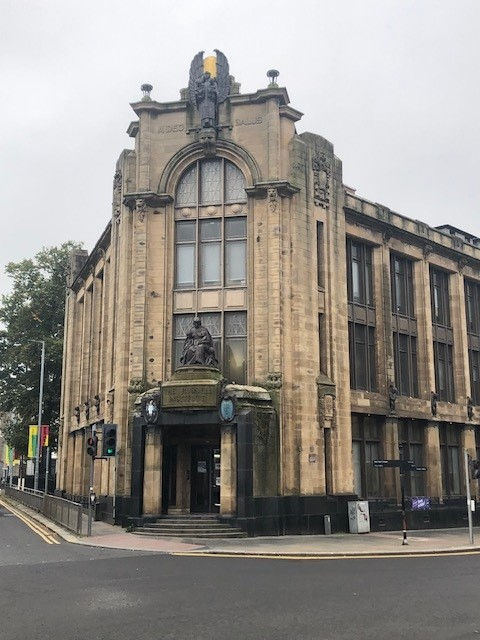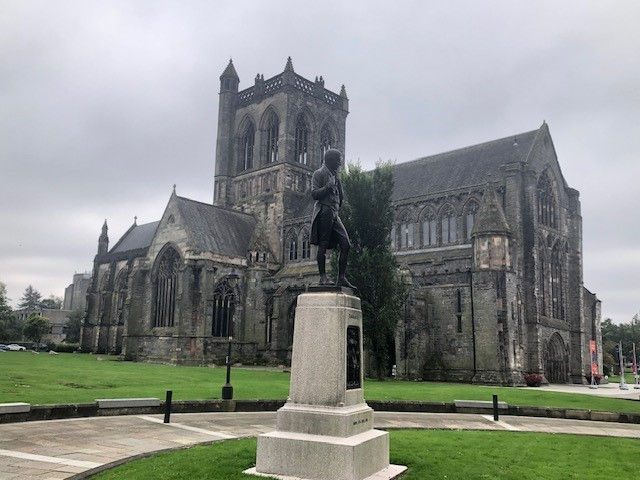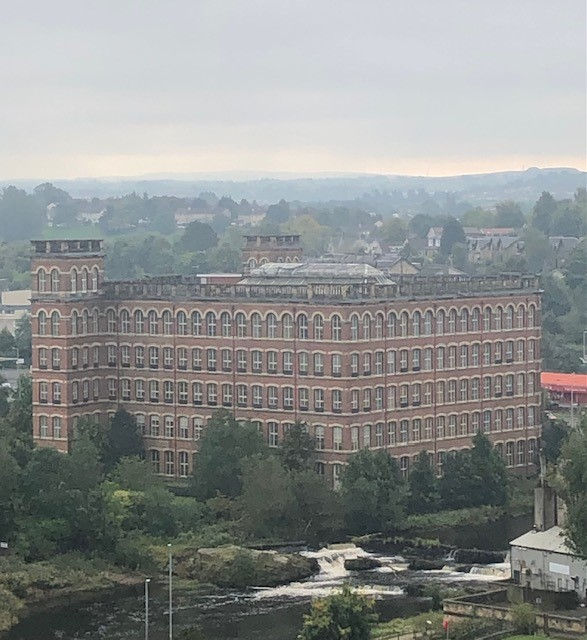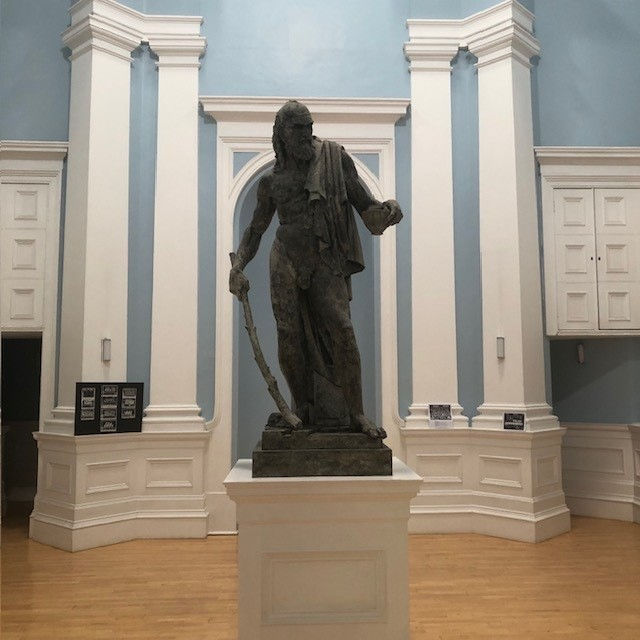The month of September offers many opportunities to explore local heritage across Scotland. Each local authority organises a programme for Doors Open Day, allowing the public to tour historic buildings and other interesting locations. Having a peek behind the scenes is all part of the experience. I perused the online brochure and noticed Paisley was offering a number of venues that appealed to me as part of the Renfrewshire schedule. I took a bus to Glasgow and wandered down to Central Station, where frequent trains depart along a busy channel to Paisley Gilmour Street, a mere ten minutes away. The four-platform early-Victorian facility opened in 1840 and services fan out to Greenock, Wemyss Bay, Largs and Ayr/Stranraer.

Scotland now has eight official cities but Paisley - despite having a population of 80,000 - remains steadfastly a town. Our largest at that! I was on familiar ground as I’d undertaken a heritage walk a couple of years ago. Today's itinerary encompassed as handful of sites in the town centre, which meant the walking distances would be short. My first port of call was the Russell Institute, now a council-owned employment hub. A tour had just started as I arrived and I joined the group. The A-listed building was commissioned by Agnes Russell and donated to Paisley Burgh, as a memorial to her two bachelor brothers Robert and Thomas who had run a successful law firm in the town. Miss Russell stipulated that the building be used as a clinic for the children of Renfrewshire and placed no financial restrictions on the construction phase. Work commenced in 1924 and the project made architectural history by using the first skeleton fabric of reinforced concrete in the West of Scotland. It was clad in Blaxter Freestone from the Borders, on a base of black Aberdeen granite. The windows were arranged to provide the maximum amount of natural light without distracting from the overall external appearance and have quite imperishable bronze frames. Italian marble was used internally to embellish the large hall and main staircase. Busts of the brothers ("Rab" and "Tam") flank the first set of bannisters. The formal opening ceremony was performed by the Princess Royal in 1927 but Miss Russell unfortunately didn't live to see this event, having passed away the previous year. The property was eventually absorbed into the NHS and functioned as a medical centre until 2011, when it closed. After a few years of dereliction, Renfrewshire Council secured funding from the Scottish Government through the Regeneration Capital Grant Fund, Historic Environment Scotland to help restore the building and bring it back into public use. The tour progressed through the various rooms, some of which weren't yet incorporated into the new skills hub. The old gymnasium reminded me of my early days at Beath High School on the original campus. We were shown the ancient elevator and some of the old electrical boxes and bell systems that had been left on display. A visit to the courtyard revealed hidden entrances and disused storerooms. The whole experience really did have a behind-the-curtains feel about it. Highly enjoyable. A short walk brough me to my next destination, the imposing Paisley Abbey.

Founded around 1163 as a priory by Walter FitzAlan, High Steward of Scotland, the abbey is believed to occupy the site of a Celtic church established by St Mirin in the 6th or 7th century. Not much concrete detail is known about Mirin (c. 565 - c. 620) and it is difficult to separate fact from fable. His name lives on through the local football team St Mirren - who have had many ups and downs over the years. A Catholic cathedral church in Paisley also bears the Mirin moniker. Full abbey status was granted in 1245 - answerable only to the Pope in Rome. Under royal patronage, the institution quickly became wealthy and powerful. The abbots became power brokers in national as well as local politics, and the settlement of Paisley grew around the flourishing abbey, which became a centre of trade and learning. It is rumoured that legendary freedom fighter William Wallace was schooled here. English forces burned down the abbey in 1307 as retaliation for the fifth High Steward supporting the Scottish cause during the Wars of Independence. The church was rebuilt over the remainder of the century. The sixth Steward (Walter Stewart) married Marjory Bruce, daughter of King Robert in 1315. Marjory died at the abbey the following year after a tragic riding accident, but her baby was saved and became King Robert II of Scotland - the first of the Stewart monarchs. Our present King is descended from him. Marjory is interred at Paisley, along with the two wives of Robert II. A grand tomb marks the resting place of King Robert III, for whom Queen Victoria laid a memorial stone on her visit to the abbey in 1888. A wall plaque commemorates the six High Stewards (and their wives) who are buried within the church. Seven years prior to the Scottish Reformation of 1560, the central tower collapsed and destroyed the transepts and choir. There was no serious prospect of repair during the great religious change and the walled-off nave became the parish church of Paisley. Restoration commenced in the mid-1800s and was largely complete by 1910. A magnificent timber ceiling was added in 1981. I wandered around the cavernous church, admiring the interior architecture and stained-glass windows. I decided to climb the tower, paying £4 to a local Scout troop that was organising the experience.

Our group was given the nod to ascend the narrow spiral staircase. It was a long way to the top but worth the effort as the view across the town was stupendous. The A-listed Anchor Mill with its flame-red brick exterior (pictured right) was visible by the White Cart Water. Opened in 1886, it was home to the largest thread manufacturer in the world - J & P Coats Ltd. Industrial decline forced closure in 1980. Work began in 2003 to transform the derelict textile factory into 60 luxury apartments and an innovative business space. The £11 million refurbishment respected the original structure and style, restoring the stonework, lead trimmings, arched windows, wrought iron frame, concrete floors and central atrium. The Prince of Wales opened the restored building in 2005, much to the delight of the local community. Today, it remains an exquisite reminder of Paisley’s proud industrial past and forward-thinking future. We had around 20 minutes on the rooftop to enjoy the Paisley panorama before being led back down. It had been a great start to the day and I headed along the High Street, in search of a doorway that would take me below ground-level into to the Paisley Museum store - known locally as the Secret Collection. I was ushered down a flight of steps and a long corridor stretched ahead of me, with glass-fronted storerooms on either side. Museums often own more material than they can actually display at any one time and a diverse range of objects were featured here today. The town's textile heritage was well represented with looms, spinning equipment, printing blocks, shawls and pattern books. Paisley was also known worldwide for producing thread. Other collections were drawn from the fields of archaeology, social history, science, ceramics, natural history and world cultures. In total, around 350,000 items are held in the vaults. An interesting walk through an Aladdin's cave of treasures! The actual museum is currently undergoing a £45 million refit and is scheduled to reopen in 2025 - a couple of years later than anticipated. I shall certainly visit. I walked past the rebuilding project en route to my next destination, the John Neilson Institution - known affectionately as the Porridge Bowl due to the shape of its dome. Neilson, a Paisley merchant, set up a trust to build a boy's school for disadvantaged learners and the project was complete by 1852. Entry was granted to pupils who had lived in Paisley for a least three years, and whose parents were either poor or deceased. The school eventually moved to new premises in 1968 and the original building (now A-listed) was converted to luxury apartments in the 1990s. The central atrium (formerly the school hall) is available to view on Doors Open Day.

I gazed up at the glass dome that floods the communal space with natural light. Several doors led off to private flats and information about the building's history was posted on the walls. The centrepiece of the redevelopment is a statue of Greek philosopher Diogenes, who holds a miniature porridge bowl in his left hand. The artwork was designed by famed local sculptor Alexander Stoddart, who is a former John Neilson's pupil and currently the King's Sculptor in Ordinary for Scotland - a royal household position created by Queen Victoria in 1838. I walked downhill and passed below the railway line to reach the next venue on the list, grabbing a bite to eat on the way. Paisley Sheriff Court has occupied its current premises since 1885. Once again, a tour was just departing as I arrived and I joined the group. Quite a few families were present. An open day is a cheap excursion and I should imagine the chance to see the cells and climb aboard the paddy wagon appeals to kids. Certainly more so than old churches. We were led through the secure corridors and invited to peek through the bars. Perhaps a few temporary residents would arrive later in the evening. The secure vehicle used to transport prisoners could hold around 20 people and was decidedly cramped. Then it was up to the main courtroom to observe a mock trial and learn about the judicial process. The tour the proceeded to a grand part of the building that formerly served as the central offices for Renfrewshire County Council until 1971. The rooms are now used for small-scale hearings and various legal meetings. For my final stop of the day, I planned to combine an educational visit with some liquid refreshment. It was the first time I'd ever seen a working brewery feature on the Doors Open schedule and - moreover - the tap room would be open to visitors. An easy wander to an industrial estate on the fringes of the town centre brought me to the headquarters of Two Towns Down Brewing. This time, a tour was well in progress when I entered and I headed for the bar instead. Couldn't have timed it better! I perused the selection board and ordered myself a pint of These Streets - a 4% pale ale priced at £5.50. Twelve taps were in action and a wide variety of styles on offer, including a bought-in cider. I got chatting to the barman and found out that Two Towns Down isn't a cask-ale operation, rather high-quality keg. Arguments have raged among CAMRA (Campaign for Real Ale) members over recent years about the emergence of lovingly-made craft beer. My opinion on the matter is quite simple. It may not fit the strict definitions of real ale in terms of storage and dispense, but it can be bloody tasty. Good enough in my book.

Like many modern microbreweries, Two Towns Down is situated within a light industrial estate. Owner Sandy McKelvie was formerly employed at 71 Brewing Dundee, before moving back to his home turf in 2023 to establish Paisley's first new brewery in over a century. The tap room is open every Saturday from 2pm to 10pm and takeaway cans can also be purchased. I sampled a half pint of Orange Crush stout and managed to get it down before the start of the next tour was called. As a small producer, everything was contained in one room and the processes of mashing, fermenting and conditioning were explained to us. One of the large vessels had a dent in the side, apparently damaged in transit from China. The filled kegs are drained by thirsty customers on site or are sent out to the pub trade. As is the case with most new craft breweries, cans rather than bottles are the favoured method of packaging for retail outlets. I had always assumed this was to keep the weight down during transportation but - while that is a factor - the main reason is that canning machinery is cheaper to install and takes up far less space than a bottling line. Back at the bar, I tried a half pint of Mango Pale Ale (a whopping 7%) and head honcho Sandy came over for a chat. It was good to see the place doing a fairly brisk trade. Not everyone was here just for the open day. Greater Glasgow was always a tough nut for the cask ale brewers to crack. Tennent's Lager rules the roost but craft ales are finding a way into the market. Best of luck to Two Towns Down. I made my merry way back to Gilmour Street and hopped on a train to Glasgow Central. A fascinating day.





